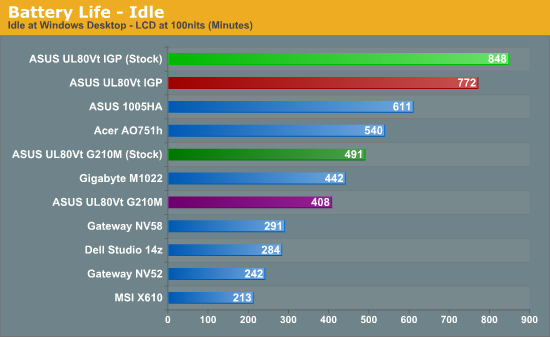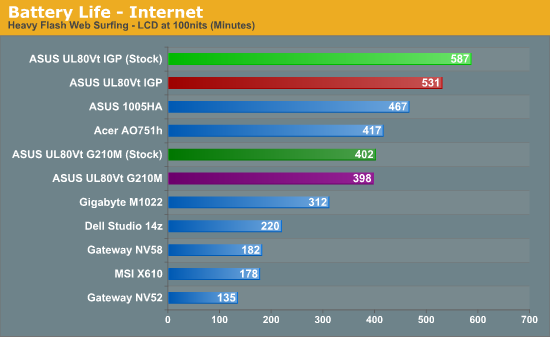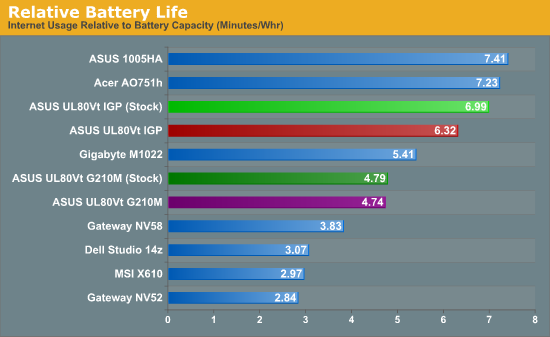ASUS UL80Vt and G51J: Going for the Gold
by Jarred Walton on December 15, 2009 1:30 AM EST- Posted in
- Laptops
ASUS UL80Vt Battery Life




The coup de grace for the UL80Vt is the battery life. Look at those charts and try to find anything else for $800 that can match the ASUS UL80Vt. (Note: the ASUS UL30Vt doesn't count, since it's pretty much the same laptop in a slightly smaller package.) Netbooks are able to offer competitive battery life, sure, but they're less than half as fast. The best-case Idle battery life tops out at just over 14 hours, but even a more demanding test where we load four web pages every 60 seconds - including one page with three Flash ads - still ends up at nearly 10 hours using the IGP and stock CPU speed. What's more, you can run with Turbo33 and the G210M and still get over 6.5 hours of web surfing.
We've dropped the other video playback tests, mostly because they're all very similar to the x264 results. HD DivX will last about 10-15% longer, and lower resolution videos would also improve on the results, but in general you can expect 5 to 6 hours of video playback with the UL80Vt.
The relative battery life is the final element, putting things into perspective. The UL80Vt has a higher capacity battery, so getting more mobility is somewhat expected. In the lowest power mode (IGP + stock CPU) the UL80Vt can provide nearly seven minutes per Wh, which is just slightly less than the ASUS 1005HA netbook. Turn on Turbo33 and battery life drops by about 10%. Running stock with the G210M enabled on the other hand results in a drop of 46%. Internet surfing with Turbo33 + G210M doesn't really change compared to stock with G210M, with only a 1% drop. The results here are in a test that happens to be more demanding than our MacBook testing, so the stellar battery life is even more impressive. Is it any wonder we're impressed with the ASUS UL80Vt? You get awesome battery life with reasonable gaming and application performance, all for just $800.










66 Comments
View All Comments
tpurves - Tuesday, December 15, 2009 - link
14" monitor and only 768 vertical pixels? what the hell is up with that?my WXGA 12" laptop has 800 vertical pixels and would still be usable with even slightly higher DPI if it was possible.
What is the point of carrying around the extra pounds and inches of a 14" screen if you have fewer useful pixels if you are not doing at least better than wxga.
I already think wxga at 13" (like on macbooks) is a waste of space.
A 14" should be at least 1440x900 (or the HD aspect-ratio equivalent) or what's the point of hauling that much computer and screen around?
iamezza - Wednesday, December 16, 2009 - link
One business I installed a new PC at a while back complained they couldn't read the new 19" screen. Once I showed them how to change the resolution they changed the res to 800x600.iamezza - Wednesday, December 16, 2009 - link
One business I installed a new PC at a while back complained they couldn't read the new 19" screen. Once I showed them how to change the resolution they changed the res to 800x600.JarredWalton - Tuesday, December 15, 2009 - link
Ah, youth... ;-)Do you know how many 40+ people I've had COMPLAIN to me when I set a laptop to the native resolution? There are competing views on LCD resolutions. Older users with less than perfect eyesight prefer larger pixels, in which case the 1366x768 14" LCD is a good compromise. Younger enthusiasts often prefer crazy pixel pitch like 1600x900 in a 14" LCD.
Heck, I did some work for a dentist building PCs and gave the receptionists 22" 1680x1050 displays. Guess what they run them at: 1280x800! Ugh.... Anything higher than that and they complain that it's too hard to read.
For reference:
1366x768 14" is .227 pixel pitch
1280x1024 14" is .217 pitch
1440x900 at 14" is .209
1600x900 at 14" is .194
Personally, I'm good to about .200 pixel pitch, but older folks will often want more like a .250 pitch. On desktops, 1920x1200 on a 27" LCD is fine (.300), on a 24" it's "okay" (.270), and native resolution on 30" requires me to use magnification or set a higher DPI in windows (.252).
Of course, I'd also be happier with 16:10 aspect ratio displays on laptops instead of 16:9 (or possibly even 4:3, though that's debatable). First, though, give me a contrast ratio that doesn't suck.
fabarati - Tuesday, December 15, 2009 - link
1440x900 is quite nice on a 14" screen. I'd even like a higher resolution.But the displays used on old Asus 14" laptops (I've had a A8Js and i presently use a F8Sa) leave a lot to be desired. Though you should know that, as you tested the A8Js a few years back.
On the other hand, you do get used to it. It's only when you see better displays (like my brothers SR Macbook pro or our old FSC Amilo 1437g - not to speak of the very nice S-IPS displays at my summer job) that you feel dissapointed.
pkkevin - Tuesday, December 15, 2009 - link
I second that, I remember my dad always adjusting his native 1360*768 13.3 inch laptop to a resolution of 800X600... it is all distorted and blurry to me, but he like it that way just so he can see clearly.Great review by the way, Great informations.
darwinosx - Tuesday, December 15, 2009 - link
What a hunk of plastic junk. The current laptop i7 is a joke as is the cheap plasticky Asus. Editors choice? You have got to be kidding me.The0ne - Tuesday, December 15, 2009 - link
I really have to say that most of you speaking about quality have little to no clue what you're actually referring to or talking about. I've worked in various engineering discipline to know that most of the "opinions" of this subject matter is in fact a personal one.At least do some research and/or go out and TOUCH the materials before making such comments. There's Walmart and Best Buy almost everywhere so it shouldn't be too difficult.
Yes, I realize that ingrained perceptions are very difficult to overcome but man, so people are just dense.
JarredWalton - Tuesday, December 15, 2009 - link
Which of course is posted by a Mac fanboy. Thanks, darwinOSX for being so open to other options.Would I prefer a nicer aluminum body? Sure I would! But that would also increase costs substantially. I would rather have a better LCD first, then a better construction. At that point we're looking at $1000, just like the aluminum MacBook, but it would still have substantially faster graphics and better battery life when you want it. Anyway, that's why the UL80Vt is a Silver and not a Gold.
As it stands, I have looked at dozens of laptops during the past year and these are both far better than competing models (i.e. similar pricing). We've praised MacBooks plenty, and they still have a place for anyone buying a laptop. If you don't want to run OS X, though, Apple has little to offer. "DUAL BOOT! And get 30% less battery life under Windows because we don't think anyone should even consider something other than OS X!" Thanks but no thanks.
darwinosx - Tuesday, December 15, 2009 - link
I'll take the MacBook in a heartbeat over this. I've seen the aluminum MacBook at $1049 at MacConnection and the plastic Macbook at $849. No contest over this cheapo Asus.